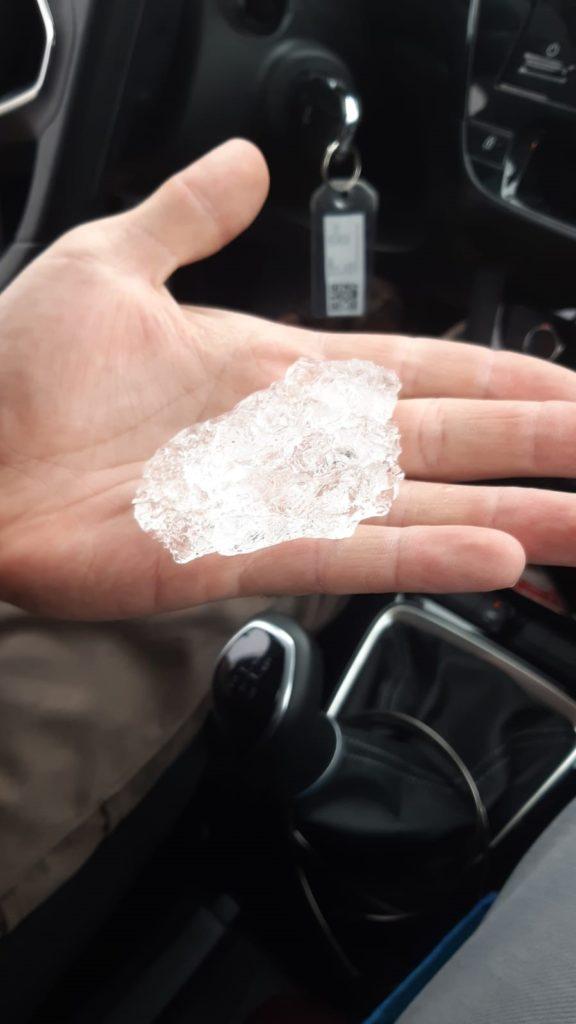VALEMO operates in several wind farms (in particular on the group’s farms such as Arfons, Albine and La Luzette) located in areas regularly subject to icing phenomena in winter. The problem of icing has a significant impact on the operation of wind farms. Indeed, the production losses due to icing amount to an average of 2200 MWh/year on the fleet currently operated by VALEMO (even if a good part of these losses are taken into account in the studies). Moreover, as the operator of these plants, VALEMO is responsible for safety in the vicinity of the ENR plants and must guarantee the safety of people near the installations.
The two figures below show that large amounts of ice can accumulate on the blades during an icing event. In case of a start-up, blocks can be ejected hundreds of meters around the machine.


In order to address this issue, VALEMO is participating in collaboration with Météo France in the development of an ice forecast model for wind turbine blades. Météo France has developed an ice accretion forecasting system: WIRE (Winter Risks for Energy) dedicated to alert actors of the energy and transport sectors to winter weather risks. WIRE uses data fields from the numerical weather prediction model AROME (Temperature, Humidity, Pressure…) to make these forecasts.
Initially dedicated to the prediction of frost and snow accretion on power transmission cables (Bouilloud L., 2017), WIRE was subsequently transposed to frost accretion on wind turbine blades. A first internship carried out at VALEMO in 2019 with Météo France allowed to realize this work of transposition and adaptation to the wind sector (taking into account the rotary motion of the blades, modification of reference frame…). A validation of WIRE could be carried out during this training course by relying on the data of the driving center of VALEMO and data of exploitation of several parks sensitive to the phenomenon of frost. The results obtained were very encouraging. We renewed the partnership with Météo France in 2020 to go further in the development of the model and in particular to validate the addition of a melting module in WIRE. A second internship, this time supervised by VALEMO, allowed us to implement this work (Dupont R., 2020). In order to be able to proceed with this validation, the VALOREM / VALEMO design office instrumented, during the fall of 2019, two wind turbines of the Albine wind farm that are very sensitive to icing. However, the winter of 2019/2020 was particularly mild and dry on this site and no icing episodes were recorded. The validation of the melting module was therefore based on the use of observation data of snow mantles on a cable at the Col de Porte (Isère, Massif de la Chartreuse), a test site of Météo France.

The figure above shows the simulated snow depth for different parameterizations tested during this course. We can see that depending on the assumptions made, the model behaves differently. Some parameterizations make the snow melt too quickly while others are more conservative. Finally, the results obtained were very promising with a detection of 11 events out of 14, i.e. a rate of 78.57% associated with a low false alarm rate evaluated at 7.46%.
Aware of the stakes related to the icing problem (also taking into account the forthcoming arrival of the future Finnish wind farms) and the promising results obtained following these two internships, VALEMO is engaged since October 2021 in a CIFRE thesis project, in collaboration with the CNRM (Centre National de Recherches Météorologiques) in order to continue the improvement of the WIRE icing prediction model and to have a tool that can be used operationally for the exploitation of the wind farms.

Currently, WIRE is still in experimental phase. Météo France provides us with this tool during the entirety of the thesis in order to make improvements. For the moment, a visualization of the icing risk is available (the more the color tends to purple, the more the risk of icing is high). In the future, graphics allowing a visualization of the icing thickness predicted by the model for the next 24, 48 hours will be added.
The ambition of this thesis is to improve the whole icing risk prediction chain for the management of wind farms, by working, in a first step, on the performance of the numerical weather prediction model AROME, then, in a second step, on the performance of the icing accretion model WIRE, and, finally, on the representation of uncertainties via probabilistic forecasting methods. This work will allow VALEMO to :
- Implement a wind turbine operation and control strategy. This would limit the mechanical loads due to ice on the wind turbine blades, and potentially limit ice accretion on the blades.
- Restart the wind turbines as soon as possible and safely in order to optimize production losses, knowing that it is the operator who must make the decision to restart and the associated risks, and not the turbine manufacturer.
Référence : [1] : R. Dupont, R. Legrand, L. Bouilloud, C. Taymans,
« Modeling frost accretion on wind turbine blades »


